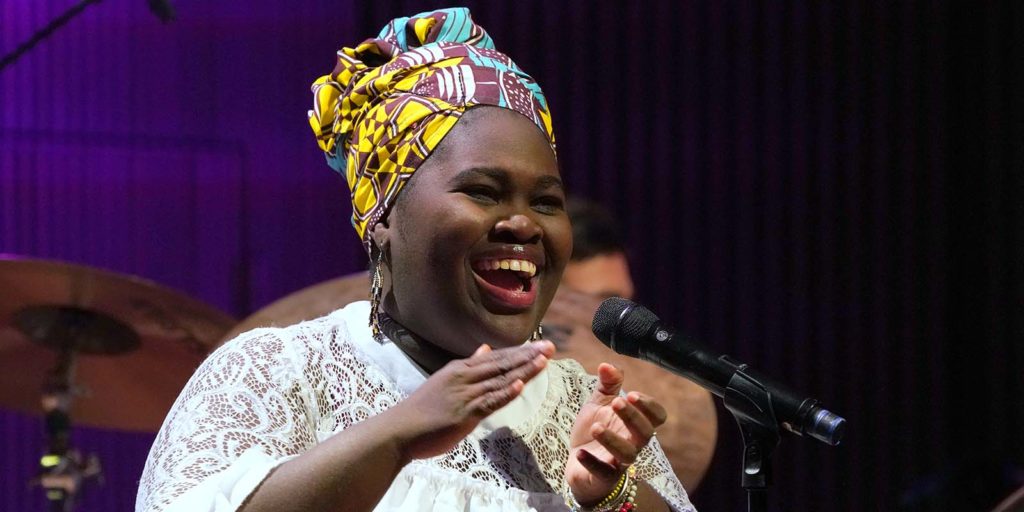Daymé Arocena is a Cuban singer, composer and bandleader who makes the sweetest Latin jazz from her rumba roots and classical music education.
Robin Denselow of “The Guardian” (a global English newspaper) called her “Cuba’s finest young female singer.” Arocena really is that. She is one of the first female voices you think of in Cuban jazz today and she is still very young, in her 20s.
Daymé has a stronger connection with her audience than any of the artists we have covered over the years. We’ve never seen such an outpouring of affection.
We met her in Puerto Rico at an El Laberinto del Coco concert. Daymé is a small woman with a very big stage presence. There is something very spiritual about her.
Daymé Arocena joins the Dizzy, Chano and Chico concert by Arturo O’Farrill & the Afro Latin Jazz Orchestra; at The Town Hall in Midtown; on Saturday, January 14, 2023 at 8pm. From $43. thetownhall.org 🇨🇺
Daymé Arocena
Daymé Arocena was born in Havana, Cuba in 1992. When she was nine, she entered one of Cuba’s prestigious music schools.
Cuba has an exceptional classical arts education system. It’s a positive legacy of the Soviet era. Getting an arts education in Cuba is like going to Juilliard. You have to prove yourself every year or you are out. It’s tough, but produces the most amazing artists.
And she is Cuban meaning she grew up in one of the main forges of Latin culture in the Americas. It’s very difficult to define Cuban music because there is so much variety. The US blockade hurts the Cuban people, but allowed old Cuban traditions to survive into the present time.
In the same way that European Classical Music grew out of the chanting of monks in church rituals, a lot of Latin Music grew out of ritual traditions in Mother Africa. However, it’s not accurate to say these are African traditions because in the Americas they changed. African and colonial traditions blended together.
In Cuba, the Spanish colonizers called African religions Santería (The Way of the Saints) because in colonial times, the African Diaspora preserved their traditions by hiding them inside veneration of the Catholic saints. The Cuban traditions are rooted in Yoruba culture of Nigeria, Benin and Togo where the same sacred rhythms and dances have been used to celebrate the ancestors and Yoruba orishas (like saints) since the beginning of human time.
Colonizers say bad things about everything not European, but Santería is a beautiful and highly developed religion that is all over the Caribbean and Latin America, including in New York City. When you see a Catholic home altar in the Latin world, it often honors both a Catholic saint and a Yoruba orisha. You won’t know unless you learn to read the signs, but there is an entire parallel universe. In Cuba it is perfectly acceptable to be 100% Santero and 100% Catholic. It’s all good.
Most Latin drummers and many Latin musicians are Santeros (Santería priests). Arocena was raised in these traditions. Singing in church produced many great African American singers. In the same way, singing to our ancestors in the Santería tradition is part of the power of Daymé’s voice. That said, performances today are purely secular.
All of this together makes Daymé Arocena a really interesting artist.
From Cuba to the World
Arocena became the lead singer of Cuban big band Los Primos when she was just 14 years old. Great Jazz artists like Wynton Marsalis and Jane Bunnett noticed the young singer.
François Renié of Havana Club rum brought her into the Havana Cultura initiative where BBC radio host Gilles Peterson also began supporting her development.
Arocena is still in her twenties, but her music has made her a global phenomenon. An artist like Daymé Arocena couldn’t have come before, so it is wonderful to hear her now.
Daymé Arocena Albums
Nueva Era
Nueva Era (New Era) refers to the reopening of relations between the United States and Cuba in 2015. It is a Jazz album with Afro-Cuban flavors.
It was a wonderful moment to hear President Obama speak about how as a nation we could make mistakes, but could also correct them.
One Takes
Also in 2015, Arocena worked with Gilles on the Havana Club Rumba Sessions, his survey of Rumba culture.
Cubafonía
Cubafonía (2017) represents a maturing of Arocena’s art. On the album, she got to work with the best musicians and production team. This enabled her to craft an even richer mix of styles.
Having toured a bit, Arocena missed home, so she made her sophomore album about Cuba. It’s a Rumba album with Cuban and Jazz flavors.
SonoCardioGrama
SonoCardioGrama (2019) is deep in the Jazz tradition. People call Daymé somewhere between Celia Cruz and Aretha Franklin.
Here she digs deeper into her Cuban Santería roots. Santería is a beautiful Afro-Cuban religion that is cherished across the Caribbean and in New York too. In colonial times, we were forced to hide our faith, but not anymore. There is really nothing to hide. It’s a rich faith based on Yoruba traditions of West Africa. Most Caribbean drummers and many musicians are Santeros.
Listening to Daymé, one moment you’re in church and the next you’re on the beach in Cuba. And then you’re in a New York Jazz club. She flows naturally between worlds and it’s a beautiful ride. She is a love shower.
SonoCardioGrama is a “sound message from the heart.” In the album’s cover image, Daymé is probably channeling Yemayá, the Great Mother of the Sea. Yemayá is the mother of the fishes, and we humans are the fishes. Yemayá loves all her children. This is the sparkle in Daymé’s voice. It’s pure love.
Coverage of Daymé Arocena was originally sponsored by the World Music Institute. Thank you!

